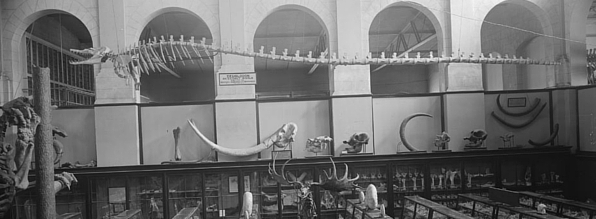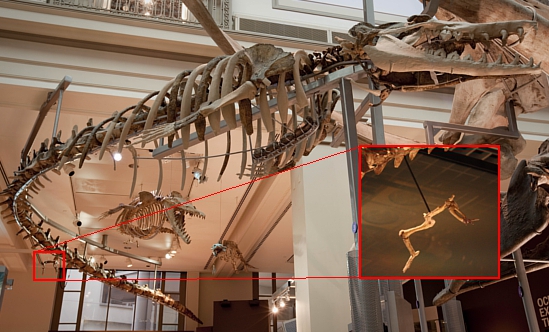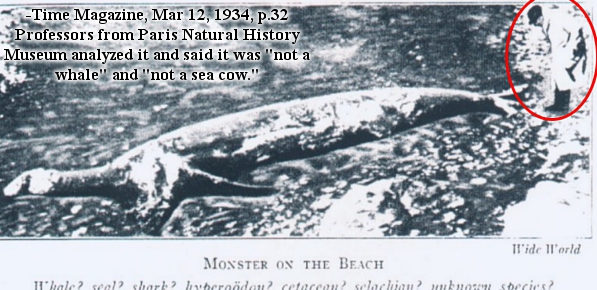
"According to the previously shown whale evolution diagram,Basilosaurus was the precursor to modern whales, one of the missing links."
-Carl & Debbie Werner, Evolution: The Grand Experiment, New Leaf Publishing Group, 2007, p. 144, ISBN: 9780892216819
Although other so-called "missing links" in the whale evolution model (e.g. pakicetus, ambulocetus, etc) were all based on a few bone fragments, complete skeletons of basilosaurus have been discovered many times in the US over the past 100 years. George Goode and Charles Schuchert were the first to assemble a complete skeleton of basilosaurus for display in 1896.

First of all, before we go any further, we need to clarify that no fossils can possibly be considered as evidence for evolution. If a scientist finds a set of bones in the ground, there is only one thing he can determine absolutely: It died. He doesn't even know where it died--he only knows where it ended up getting buried. There is no way for a scientist to prove that the bones he found in the dirt had any children, and even if he could, there is no way to prove that those bones had children that lived and reproduced, so he can't say that it is the ancestor of anyone. When an evolutionist says "we have these bones, and that is evidence for evolution," don't be fooled because he/she has no idea what they're talking about.
So with the understanding that no fossils can be considered evidence for evolution, how are evolutionists coming to the conclusion that basilosaurus is an evolutionary ancestor of modern whales? The Smithsonian Institute tells us:
"Thehind limb provides a clue to the evolutionary past of Basilosaurus."
-Smithsonian National Museum of Natural History, "Basilosaurus," Celebrating 100 Years: Explore Our Collections, retrieved Feb 10, 2012, [www.mnh.si.edu])

Those little bones are what evolutionists are claiming has led them to believe that land dwelling mammals went into shallow water, lost their legs, evolved flippers, and became whales. If you're thinking "this sounds ridiculous," that's because it is ridiculous. It's all about the claim that these bones have no function, and therefore, they claim, are vestigial remnents of evolutionary past. That's exactly what the public school textbooks are teaching:

These are claimed to be remnents of evolutionary past, but are done so on no other basis than imaginary thought. These bones were designed and placed with a function, and even evolutionary "experts" understand that function:
"It seems to me thatthey could only be some kind of sexual or reproductive clasper."
-Phillip Gingerich (discoverer of pakicetus), quoted in The Press-Enterprise, July 1, 1990, p. A-15
Whales have always used these bones in reproduction becasue they are very large creatures, and to get the sexual organs to align properly, they need the muscles that attach to those bones to adjust themselves. But we still find evolutionists teach teaching the "no function" lie because they have nothing else to explain their imagined whale evolution. These similar types of bones are found in similar types of sea dwelling creatures becasue it's a common reproductive design that works.
2. They were once legs. (It's okay to laugh at #2, it's pretty funny.) |

"Dr. Lawrence Barnes, a whale evolution expert from the Natural History Museum in Los Angeles, does not believe Basilosaurus was an ancestor to modern whales because this whale lived at the same time as the more modern forms of whales and,therefore, could not be the precursor ... Apparently,not all agree on Basilosaurus being the last ancestor prior to the evolution of the modern forms of whales. "
-Carl & Debbie Werner, quoted Dr. Lawrence Barnes, Evolution: The Grand Experiment, New Leaf Publishing Group, 2007, p. 144, ISBN: 9780892216819
"The serpentine form of the body [of basilosaurus] and the peculiar serrated cheek teeth made it plain that these archaeocetescould not possibly have been ancestral to any of the modern whales. "
-Barbara J. Stahl, Vertebrate History: Problems in Evolution, Dover Publications, 1974, p. 487, ISBN: 9780486648507
Though the evolutionists believe this creature to have gone extinct 35 million years ago, it is possible that the basilosaurus kind of animal is still alive in some parts of the world. I don't know if it is or isn't (nor do I make that claim), but there are some very interesting eye-witness accounts of sightings of a creature fitting the basilosaurus description.
(Evolutionists have claimed this is an orca whale, but you be the judge.)


Why is it so difficult for evolutionists, who claim to be scientists, to entertain the possibility that these might be the basilosaurus? Because it does not line up with their imaginary, pre-conceived geologic column, which is the bible of the evolutionist. In a nutshell, the evolutionist says, "We know it can't be a basilosaurus because we believe it can't be a basilosaurus." The evolutionist is left unwilling and unable to investigate certain scientific inquiries because their presupposed religion will not allow them to do so.













![There is No Saving Grace Without Repentance [creationliberty.com]](../images/store13a.jpg)
![Wolves in Costume: Kent Hovind [creationliberty.com]](../images/store11a.jpg)
![Corruptions of Christianity: Seventh-day Adventism [creationliberty.com]](../images/store09a.png)
![501c3: The Devil's Church [creationliberty.com]](../images/store07a.jpg)
![Feminism: Castrating America [creationliberty.com]](../images/store04a.jpg)







![Why Millions of Believers on Jesus Are Going to Hell [creationliberty.com]](images/store05a.jpg)
![Corruptions of Christianity: Catholicism [creationliberty.com]](http://www.creationliberty.com/images/store14a.jpg)
![False Prophet Profiles: Kim Clement [creationliberty.com]](http://www.creationliberty.com/images/store12a.jpg)
![Christmas: Rejecting Jesus [creationliberty.com]](http://www.creationliberty.com/images/store10a.jpg)
![Christian Music: For The Love of Money [creationliberty.com]](images/store08a.png)
![Psychology: Hoodwinked by the Devil [creationliberty.com]](images/store06a.jpg)
